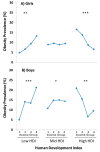International Study of Childhood Obesity, Lifestyle and the Environment (ISCOLE): Contributions to Understanding the Global Obesity Epidemic
- PMID: 30991687
- PMCID: PMC6521223
- DOI: 10.3390/nu11040848
International Study of Childhood Obesity, Lifestyle and the Environment (ISCOLE): Contributions to Understanding the Global Obesity Epidemic
Abstract
The purpose of this review is to summarize the scientific contributions of the International Study of Childhood Obesity, Lifestyle and the Environment (ISCOLE) in extending our understanding about obesity in children from around the world. ISCOLE was a multi-national study of 9 to 11 year-old children from sites in 12 countries from all inhabited continents. The primary purpose was to investigate relationships between lifestyle behaviors and obesity, and the influence of higher-order characteristics such as behavioral settings, and physical, social and policy environments. ISCOLE has made several advances in scientific methodology related to the assessment of physical activity, dietary behavior, sleep and the neighborhood and school environments. Furthermore, ISCOLE has provided important evidence on (1) epidemiological transitions in obesity and related behaviors, (2) correlates of obesity and lifestyle behaviors at the individual, neighborhood and school levels, and (3) 24-h movement behaviors in relation to novel analytical techniques. A key feature of ISCOLE was the development of a platform for international training, data entry, and data quality for multi-country studies. Finally, ISCOLE represents a transparent model for future public-private research partnerships across low, middle and high-income countries.
Keywords: collaboration; epidemiological transition; overweight; pediatric.
Conflict of interest statement
The authors declare no conflicts of interest. With the exception of requiring that the study was global in nature, the funder had no role in the design of the study; in the collection, analyses, or interpretation of data; in the writing of the manuscript, or in the decision to publish the results.
Figures





References
-
- NCD Risk Factor Collaboration (NCD-RisC) Worldwide trends in body-mass index, underweight, overweight, and obesity from 1975 to 2016: A pooled analysis of 2416 population-based measurement studies in 128.9 million children, adolescents, and adults. Lancet. 2017;390:2627–2642. doi: 10.1016/S0140-6736(17)32129-3. - DOI - PMC - PubMed
-
- Riddoch C., Edwards D., Page A.S., Froberg K., Anderssen S.A., Wedderkopp N., Brage S., Cooper A.R., Sardinha L.B., Harro M., et al. The European youth heart study—Cardiovascular disease risk factors in children: Rationale, aims, study design, and validation of methods. J. Phys. Act. Health. 2005;2:115–129. doi: 10.1123/jpah.2.1.115. - DOI
-
- Moreno L.A., De Henauw S., Gonzalez-Gross M., Kersting M., Molnar D., Gottrand F., Barrios L., Sjostrom M., Manios Y., Gilbert C.C., et al. Design and implementation of the healthy lifestyle in Europe by nutrition in adolescence cross-sectional study. Int. J. Obes. 2008;32(Suppl. 5):S4–S11. doi: 10.1038/ijo.2008.177. - DOI - PubMed
-
- Van Stralen M.M., te Velde S.J., Singh A.S., De Bourdeaudhuij I., Martens M.K., van der Sluis M., Manios Y., Grammatikaki E., Chinapaw M.J., Maes L., et al. EuropeaN energy balance research to prevent excessive weight gain among youth (ENERGY) project: Design and methodology of the energy cross-sectional survey. BMC Public Health. 2011;11:65. doi: 10.1186/1471-2458-11-65. - DOI - PMC - PubMed
Publication types
MeSH terms
Grants and funding
LinkOut - more resources
Full Text Sources
Medical

